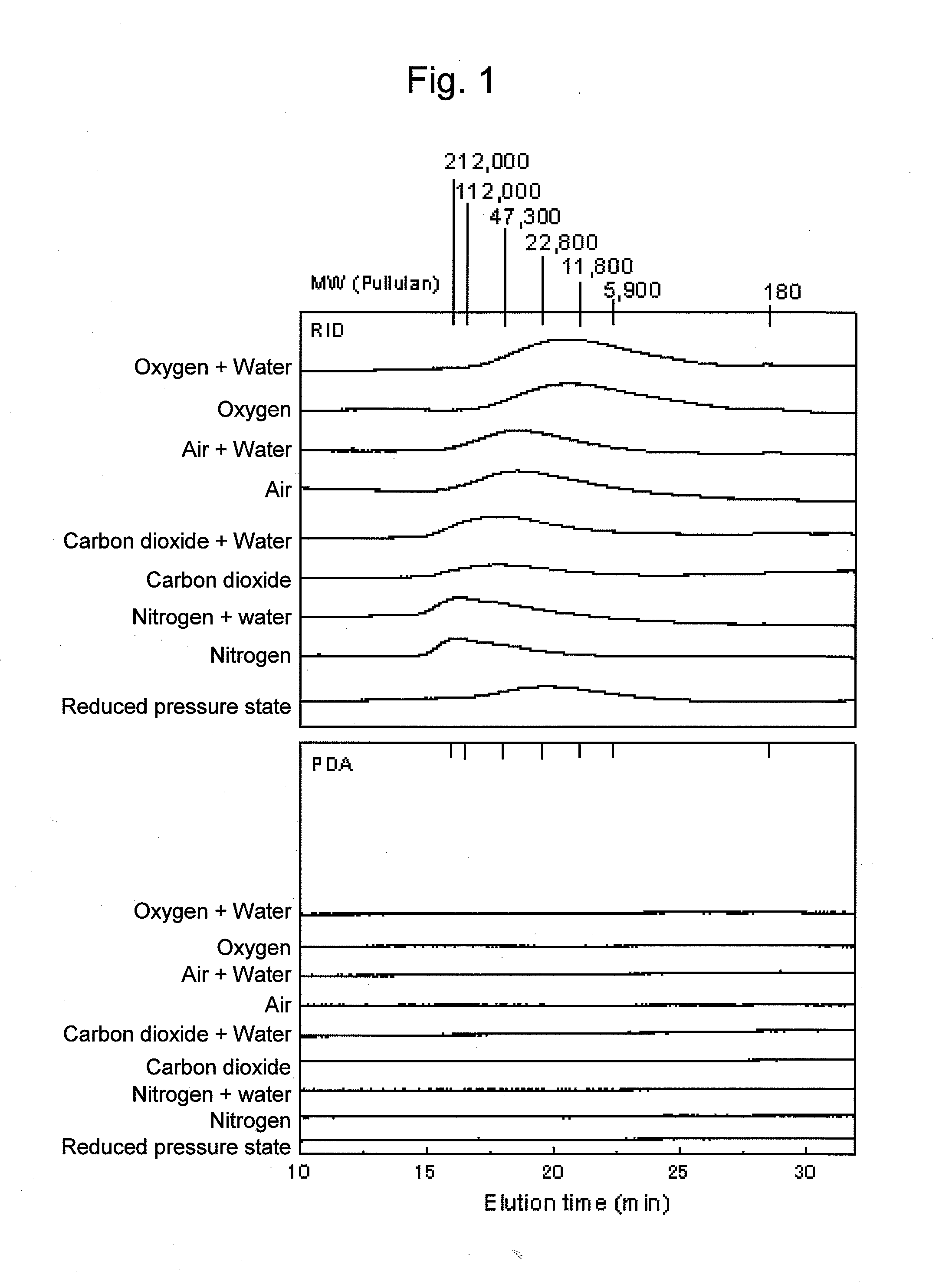Method for controlling rate of lowering molecular weight of polysaccharides contained in cellulosic biomass, and method for producing sugar, alcohol, or organic acid
a cellulosic biomass and molecular weight technology, applied in the direction of fermentation, glucose production, biofuels, etc., can solve the problems of not knowing the control method of lowering the molecular weight of cellulose and/or hemicellulose, and achieve the effect of lowering the molecular weight and cellulos
- Summary
- Abstract
- Description
- Claims
- Application Information
AI Technical Summary
Benefits of technology
Problems solved by technology
Method used
Image
Examples
example 1
[0044]In this Example, an experiment for lowering the molecular weight of cellulose and hemicellulose contained in a cellulosic biomass was conducted under various atmospheres using 1-ethyl-3-methylimidazolium chloride as ionic liquid.
[0045]Specifically, 3 g of 1-ethyl-3-methylimidazolium chloride was added to a sealed round-bottom flask and then heated at 120° C. Under such conditions, 90 mg of absolutely dry western red cedar wood flour was added to the flask and then the mixture was agitated while supplying oxygen, nitrogen, carbon dioxide, pseudo-air, or each such gas containing moisture at a rate of 10 ml / minute. At 3 hours and 24 hours after initiation of the treatment, soluble components were separated from insoluble components by absorption and filtration. Similarly, 3 g of 1-ethyl-3-methylimidazolium chloride was added to a sealed round-bottom flask and then heated at 120° C. Under the conditions, 90 mg of absolutely dry western red cedar wood flour was added to the flask a...
example 2
[0055]Each soluble component (10 μl) (separated in a manner similar to that in Example 1) was sampled and then mixed with 90 μl of distilled water. The solution was filtered and then the thus obtained filtrate was subjected to HPLC analysis. Analytical conditions were as follows.
[0056]Sample inflow: 10 μl
[0057]Column: Aminex HPX-87
[0058]Eluant: distilled water
[0059]Flow rate: 0.6 ml / min
[0060]Detector: refractive index detector and photodiode array
[0061]Column temperature: 85° C.
[0062]FIG. 3 shows the results at 24 hours after the initiation of treatment.
[0063]Results of treatment under a pseudo-air or moisture-containing pseudo-air atmosphere demonstrated that, glucose that is a monosaccharide of cellulose was contained at the highest level, and that oligomers and cellobioses of cellulose were also contained. 5-HMF that is an excessively degraded product wherein the molecular weight of glucose is somewhat further lowered was contained. On the other hand, results of treatment under a...
example 3
[0065]Each insoluble component (separated in a manner similar to that in Example 1) was thoroughly washed with dimethyl sulfoxide (DMSO) and then further washed with a sufficient volume of distilled water. The thus obtained residues were subjected to X-ray diffraction analysis using an X-ray diffractometer (Name of the apparatus: RINT2000 (manufactured by Rigaku Corporation)) under a voltage of 40 kv and a current of 30 mA. FIG. 4 shows the results of X-ray diffraction analysis at 3 hours after the initiation of treatment. Results when no treatment had been conducted showed peaks at position 2θ=22.6 indicating crystalline cellulose. However, the results regarding treatment with ionic liquid under any atmosphere showed no peaks at position 2θ=22.6, but rather were broad diffraction results. Therefore, it was understood that the crystal structure of cellulose was amorphized in samples treated under any atmosphere.
PUM
| Property | Measurement | Unit |
|---|---|---|
| Partial pressure | aaaaa | aaaaa |
| Molecular weight | aaaaa | aaaaa |
| Ratio | aaaaa | aaaaa |
Abstract
Description
Claims
Application Information
 Login to View More
Login to View More - R&D
- Intellectual Property
- Life Sciences
- Materials
- Tech Scout
- Unparalleled Data Quality
- Higher Quality Content
- 60% Fewer Hallucinations
Browse by: Latest US Patents, China's latest patents, Technical Efficacy Thesaurus, Application Domain, Technology Topic, Popular Technical Reports.
© 2025 PatSnap. All rights reserved.Legal|Privacy policy|Modern Slavery Act Transparency Statement|Sitemap|About US| Contact US: help@patsnap.com



